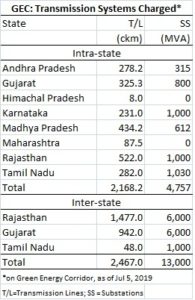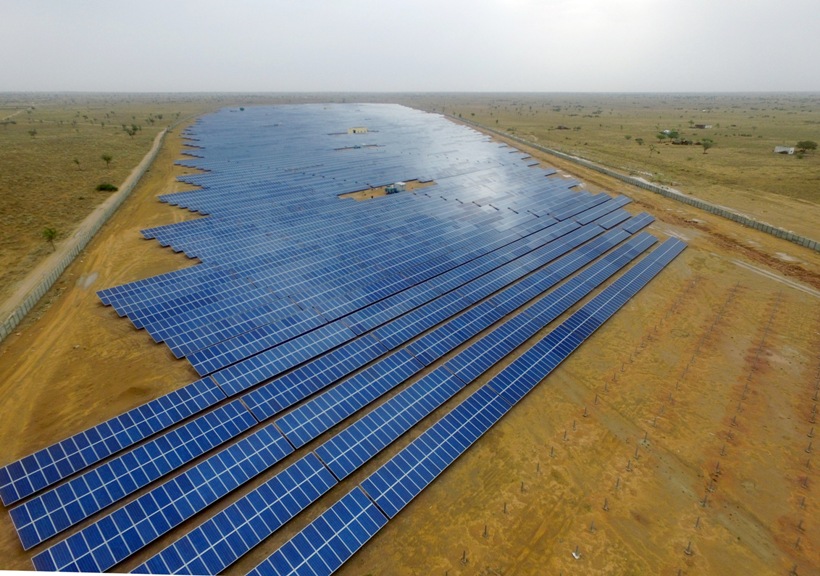Power transmission projects, structured on the tariff-based competitive bidding (TBCB) mechanism and associated with large-scale evacuation of renewable energy, are seen to be taking off, after a sustained period of lull, recent developments suggest.
Sterlite Power recently won its first set of transmission projects under the Green Energy Corridor (GEC), under the tariff-based competitive bidding (TBCB) route. In early August, Power Grid Corporation of India was declared successful bidder for two GEC projects, based on tariffs quoted. Similarly, Adani Transmission is expected to be formally awarded two green energy corridor projects, based on the TBCB modality, in the coming weeks.
 The two projects won by Sterlite Power are WRSS-21 (Part B) and the Udupi-Kasargode line. The Western Region System Strengthening (WRSS)-21 scheme is aimed at relieving overloading observed in the intrastate transmission system in Gujarat, due to renewable energy (RE) injections at the Bhuj Pooling Station. This project was won by Sterlite Power under the reverse auction route with three bidders in the final race. WRSS-21 (Part B) involves setting up of the 765kV Lakadia-Vadodara transmission line (325 km) and associated GIS substations, among other things. This project will be commissioned in a compressed time schedule of 18 months. The Udupi-Kasargode line will facilitate smoother power flow of electricity from Karnataka to Kerala. The total investment in the two projects won by Sterlite Power is estimated to be Rs.3,000 crore. The two projects are significant for Sterlite Power as the company now adds renewable energy transmission to its Indian portfolio. It may be mentioned that the company has already completed a wind energy evacuation project in Brazil earlier this year.
The two projects won by Sterlite Power are WRSS-21 (Part B) and the Udupi-Kasargode line. The Western Region System Strengthening (WRSS)-21 scheme is aimed at relieving overloading observed in the intrastate transmission system in Gujarat, due to renewable energy (RE) injections at the Bhuj Pooling Station. This project was won by Sterlite Power under the reverse auction route with three bidders in the final race. WRSS-21 (Part B) involves setting up of the 765kV Lakadia-Vadodara transmission line (325 km) and associated GIS substations, among other things. This project will be commissioned in a compressed time schedule of 18 months. The Udupi-Kasargode line will facilitate smoother power flow of electricity from Karnataka to Kerala. The total investment in the two projects won by Sterlite Power is estimated to be Rs.3,000 crore. The two projects are significant for Sterlite Power as the company now adds renewable energy transmission to its Indian portfolio. It may be mentioned that the company has already completed a wind energy evacuation project in Brazil earlier this year.
In early August 2019, Power Grid Corporation of India announced that it had won two projects of the Green Energy Corridor, under the TBCB mechanism. The first project is “Transmission System for providing connectivity to RE Projects at Bhuj-II (2000 mw)” in Gujarat. The second is the “’Transmission system associated with LTA application from Rajasthan SEZ (Part-C)”. Both the projects involve 765kV transmission lines and GIS substations. While the first project will essentially focus in Gujarat, the second will traverse Rajasthan, Haryana and Delhi.
It is also reliably learnt that Adani Transmission Ltd has been given the letter of intent (LoI) for two projects under the WRSS-21 (Part A) and “’Transmission system associated with LTA application from Rajasthan SEZ (Part-D)”. [Details presented ahead.]
It may be mentioned here that evacuation systems relating to the Rajasthan Solar Energy Zone (SEZ) forms a substantial part of the Green Energy Corridor. In its entirety, the Rajasthan SEZ transmission project involves evacuation of 20 GW of solar energy. This project will come up in two phases of 8.9 GW and 11.1 GW. These two phases have been further divided into several packages. It is noteworthy that some elements of this transmission network will have HVDC converters. Some of these packages will be awarded under the TBCB route, while the others could followed the RTM mechanism. It may be mentioned that of the 11.1 GW of infrastructure envisaged in the second phase, around 3 GW will be accounted for by existing or planned transmission infrastructure of state power utility Rajasthan Vidyut Prasaran Nigam Ltd.
Apart from the TBCB route, some elements of the Green Energy Corridor project are being implemented under the regulated tariff mechanism (RTM) route. The RTM route is adopted when the National Committee on Transmission (NCT) feels that it may not be prudent to deploy the TBCB route. For instance, if any project involves upgrade of assets already constructed, or if the project involves major technological complexity, NCT rules in favour of Power Grid Corporation of India Ltd (PGCIL) implementing the project under the RTM mechanism.
Upcoming Rajasthan SEZ projects
The power ministry has lined up quite a few power transmission projects associated with the Rajasthan solar energy zone (SEZ) that will be awarded to developers using the TBCB mechanism. As always, PFC Consulting Ltd (a subsidiary of Power Finance Corporation) and REC Transmission Projects Ltd (a subsidiary of REC Ltd) will be the bid process coordinating agencies. Some of the upcoming TBCB projects are:
- Transmission Scheme for evacuation of power from Rajasthan SEZ (8.1 GW) [Phase II –Part A]
- Transmission Scheme for evacuation of power from Rajasthan SEZ (8.1 GW) [Phase II –Part B]
- Transmission Scheme for evacuation of power from Rajasthan SEZ (8.1 GW) [Phase II –Part C] (VSC-based HVDC terminal package)
- Transmission Scheme for evacuation of power from Rajasthan SEZ (8.1 GW) [Phase II –Part C] (VSC-based HVAC package)
- Transmission Scheme for evacuation of power from Rajasthan SEZ (8.1 GW) [Phase II –Part D]
- Transmission Scheme for evacuation of power from Rajasthan SEZ (8.1 GW) [Phase II –Part E]
GEC TBCB projects
Apart from the above projects, which are still in early stages of bidding, there are two projects TBCB projects associated with green energy evacuation that have made progress on the bidding front.
For the WRSS-21 (Part A) project Adani Power Transmission has emerged as the winning bidder. (As discussed earlier, Part B of this project has gone to Sterlite Power.) However, the project will be transferred to the selected developer only after approval from CERC, which is currently pending. For the “Transmission system associated with RE generation at Bhuj-II, Dwarka and Lakadia,” five bidders have submitted their financial bids. However, since the long-term transmission customers (LTTCs) have not yet been finalized, the award of this project is pending. The “Construction of 765kV Ajmer (PG)-Phagi D/C line along with associated bays for Rajasthan SEZ” project has entered the final bidding phase with six contenders in the fray. The project is expected to be awarded during September 2019. Similar is the case with the “Transmission system associated with LTA applications from Rajasthan SEZ Part-B” project. Final price bids were scheduled for submission by nine entities qualified at the RfP stage, on August 26, 2019. The project is expected for award during September 2019.
Green Energy Corridor: Overview & Progress
The Green Energy Corridor (GEC) project, a programme under the ministry of new & renewable energy (MNRE), envisages the erection of 9,400 ckm of transmission lines and around 19,000 MVA of substations under the intrastate transmission system and 3,200 ckm of lines and 18,000 MVA of substations under the interstate transmission system (ISTS). According to information tabled in Parliament, as of July 5, 2019, 2168.2 ckm of transmission lines and 4,757 MVA of substations under the intrastate transmission system and 2,467 ckm of transmission lines and 13,000 MVA of substations under interstate transmission system have been charged under the GEC project. (See table)
It is also estimated that the GEC project so far has enhanced the overall interregional grid capacity to 100 GW.



